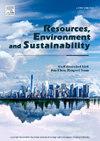Integrative analysis of transboundary land use conflicts in the Aral Sea Basin: A multi-scale assessment of drivers and strategies for sustainable management
IF 12.4
Q1 ENVIRONMENTAL SCIENCES
引用次数: 0
Abstract
Addressing escalating land use conflicts (LUCs) is critical for sustainable development in resource-scarce, transboundary regions. The Aral Sea Basin (ASB), Central Asia’s largest transboundary basin characterized by arid conditions and vulnerable ecosystems, serves as a crucial case study. This research introduces an innovative framework, integrating multi-scale spatial assessments with interpretable machine learning (XGBoost-SHAP), to overcome limitations of previous fragmented analyses and provide deeper insights into LUCs dynamics. We systematically evaluated land suitability for ecological preservation, agriculture, and urban construction, quantified conflict intensity, and identified key drivers across the entire ASB, including its Amu Darya and Syr Darya sub-basins. Quantitative results reveal profound spatial heterogeneity in land use potential, with 56.29% of the basin suitable for ecological preservation, only 6.54% for agriculture, and 72.67% for urban construction—indicating dominant ecological value, limited agricultural suitability, and high urban development pressure. Conflicts were found to be pervasive and intense, driven by a complex interplay of natural factors and socio-economic pressures, with distinct upstream-downstream patterns across sub-basins. Crucially, this study provides spatially explicit evidence highlighting the urgent need for integrated, transboundary land management. The results offer actionable, data-driven insights essential for designing targeted strategies, fostering collaborative resource governance, and ultimately promoting sustainable development pathways that balance ecological integrity with human needs in the ASB and similar complex transboundary basins worldwide.

咸海盆地跨界土地利用冲突的综合分析:可持续管理驱动因素和策略的多尺度评估
解决不断升级的土地利用冲突对资源稀缺的跨界地区的可持续发展至关重要。咸海盆地(ASB)是中亚最大的跨界盆地,其特点是干旱条件和脆弱的生态系统,是一个重要的案例研究。本研究引入了一个创新的框架,将多尺度空间评估与可解释性机器学习(XGBoost-SHAP)相结合,以克服以往碎片化分析的局限性,并为lucc动态提供更深入的见解。我们系统地评估了生态保护、农业和城市建设的土地适宜性,量化了冲突强度,并确定了整个ASB的关键驱动因素,包括阿姆河和锡尔河子流域。定量结果显示,流域土地利用潜力空间异质性较强,生态保护用地占56.29%,农业用地占6.54%,城市用地占72.67%,生态价值占主导地位,农业用地适宜性有限,城市发展压力较大。在自然因素和社会经济压力复杂的相互作用下,冲突普遍而激烈,各子盆地的上下游格局明显。至关重要的是,这项研究提供了空间上明确的证据,强调了综合跨境土地管理的迫切需要。研究结果提供了可操作的、数据驱动的见解,对于设计有针对性的战略、促进资源协作治理,并最终促进平衡ASB和全球类似复杂跨界流域的生态完整性与人类需求的可持续发展路径至关重要。
本文章由计算机程序翻译,如有差异,请以英文原文为准。
求助全文
约1分钟内获得全文
求助全文
来源期刊

Resources Environment and Sustainability
Environmental Science-Environmental Science (miscellaneous)
CiteScore
15.10
自引率
0.00%
发文量
41
审稿时长
33 days
 求助内容:
求助内容: 应助结果提醒方式:
应助结果提醒方式:


